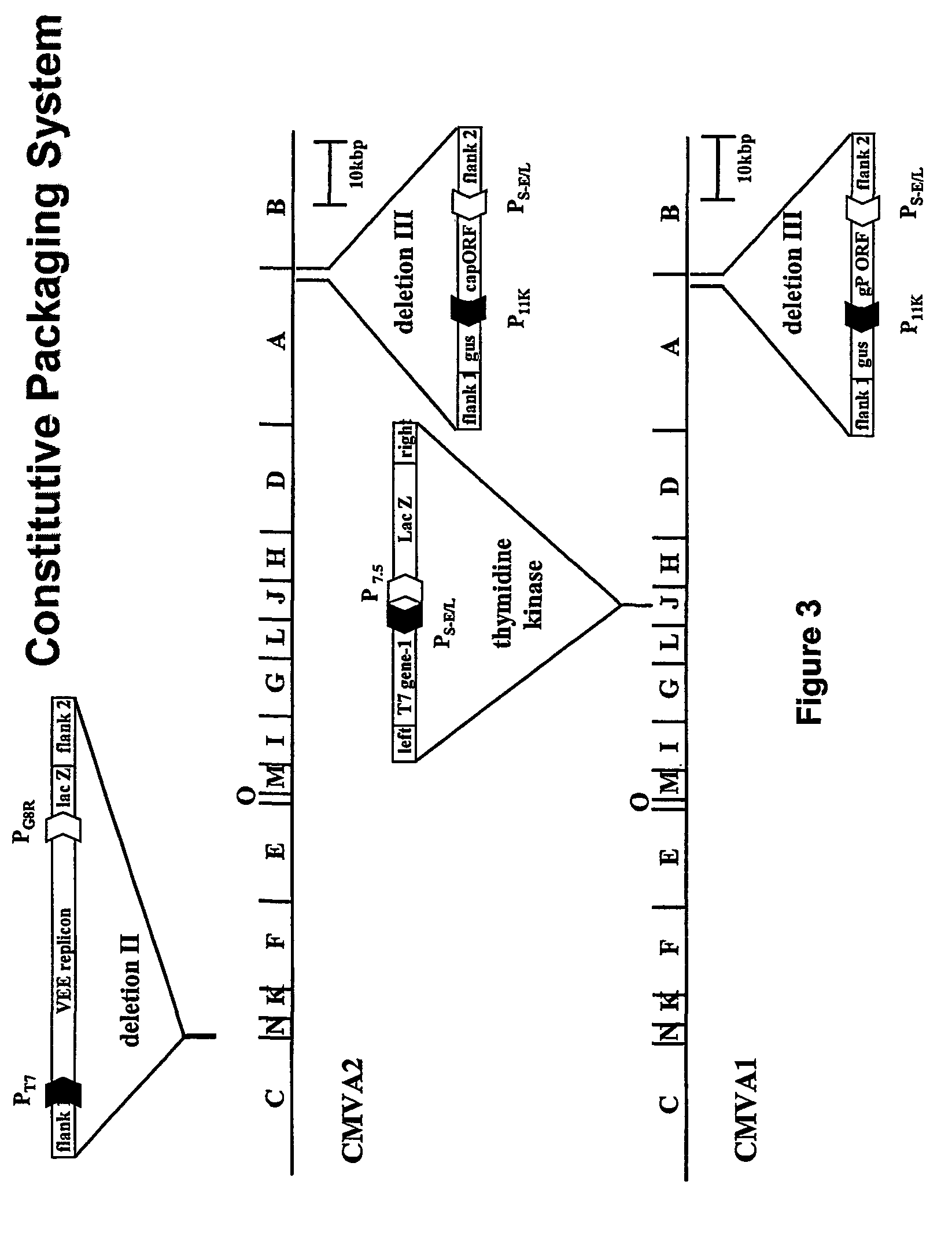Packaging of positive-strand RNA virus replicon particles
a technology of rna virus and packaging system, applied in the field of recombinant polynucleotides, positive-strand rna virus recombinant expression vectors, packaging systems, can solve the problems of not self-packaging, low packaging efficiency, and production of viable viruses
- Summary
- Abstract
- Description
- Claims
- Application Information
AI Technical Summary
Benefits of technology
Problems solved by technology
Method used
Image
Examples
example 1
Materials and Methods
1A Development of a Recombinant MVA Vector Capable of Expressing Abundant T7 RNA Polymerase Early in Infection.
[0124]A stock of MVA (24), (23), (25), obtained from Dr. Bernard Moss (NIAID), was plaque purified and amplified on certified chick embryo fibroblasts (CEF; SPAFAS) in minimal essential media (Life Technologies) supplemented with 10% fetal bovine serum (Life Technologies). This virus was utilized as the parent for insertion of all foreign genes and expression cassettes.
[0125]A recombinant MVA expression vector (MVGKT7) was engineered to express abundant amounts of the bacteriophage T7 RNA polymerase early in infection (FIG. 2). It was necessary to express abundant levels of T7 polymerase early in infection because, as demonstrated below, VEE coinfection limits expression from vaccinia late promoters. The T7 RNA polymerase gene was excised from pT7-Neo (gift of Dr. S. Lee, Wyeth Lederle Vaccines) as a BamHI fragment and subcloned into the Bg / II site of p...
example 2
Characterization of MVA and VEE Coinfection
[0134]To evaluate whether VEE coinfection of MVA infected cells would affect poxvirus early and / or late gene expression, two recombinant MVA viruses that express lacZ under the control of either a viral early promoter (MVA / 7.5KlacZ) or a late promoter (MVA / 11KlacZ) were used to infect cells with or without VEE coinfection. BHK-21 cells were infected with 10 PFU of MVA / 7.5KlacZ or MVA11KlacZ per cell alone or with 10 IU per cell of VRP / GFP. Cells were harvested at 24 hpi, and assayed for β-galactosidase activity, a measure of poxvirus gene expression (see FIG. 13). The levels of β-galactosidase detected in samples 1 and 3 of FIG. 13 are indicative of normal early and late gene expression during MVA infection, respectively. Addition of cytosine-beta-D-arabinofuranoside (AraC), a drug that blocks MVA DNA replication, shows that late but not early genes are inhibited (FIG. 13, compare sample 2 to 4). Coinfection of cells with MVA / 11KlacZ and VR...
example 3
Characterization of an Inducible MVA-based VRP Packaging System
[0137]The titers obtained by coinfection with MVA / VEEGFP / DHgP (IMVA1) and MVGKT7 / DHCap (IMVA2) (see FIG. 4) were compared to those produced with the standard split-helper RNA transfection method. BHK-21 cells were chosen as the cell substrate for packaging because they have been shown to produce the highest titers of VRP. However, BHK-21 cells are not appropriate for mass production of VRP using the MVA-based VRP-packaging systems because they are fully permissive for MVA growth (6), (13), (4). BHK-21 cells were infected with two recombinant MVA vectors constituting the inducible packaging system at an MOI of 1, 10 or 20 total PFU / cell. Alternatively, the cells were co-electroporated with VEE replicon-GFP RNA, capsid DH RNA, and gP DH RNA synthesized in vitro by T7 RNA polymerase.
[0138]Media from infected and electroporated cells were harvested at 24 h and titered on fresh BHK-21 cells. Additionally, some of the original...
PUM
| Property | Measurement | Unit |
|---|---|---|
| fluorescent | aaaaa | aaaaa |
| genome-length | aaaaa | aaaaa |
| length | aaaaa | aaaaa |
Abstract
Description
Claims
Application Information
 Login to View More
Login to View More - R&D
- Intellectual Property
- Life Sciences
- Materials
- Tech Scout
- Unparalleled Data Quality
- Higher Quality Content
- 60% Fewer Hallucinations
Browse by: Latest US Patents, China's latest patents, Technical Efficacy Thesaurus, Application Domain, Technology Topic, Popular Technical Reports.
© 2025 PatSnap. All rights reserved.Legal|Privacy policy|Modern Slavery Act Transparency Statement|Sitemap|About US| Contact US: help@patsnap.com



